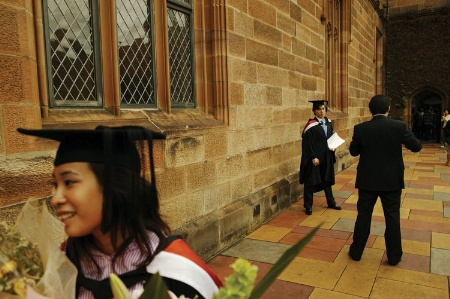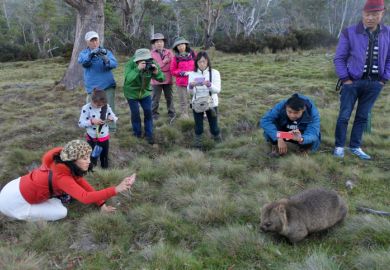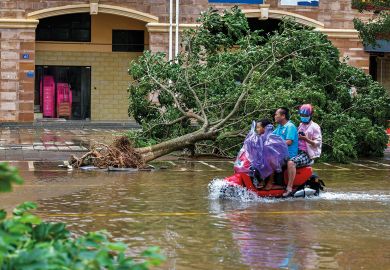Source: Getty
The determination of the Home Office to reduce UK immigration may be hampering aspirations to attract more international students, but Australia’s newly elected right-of-centre government has no such hang-ups.
Indeed, Tony Abbott’s Liberal-National Coalition, which emerged victorious from September’s general election, has been highly critical of the previous Labor government for substantially raising visa fees and financial requirements for international students in 2009 and 2010.
It did so amid fears that the route to permanent residency through tertiary education that was introduced by an earlier coalition government under John Howard, which was in power from 1996 to 2007, had led to a feeding frenzy of low-quality, unscrupulous providers of vocational qualifications.
In his first major speech on higher education last month, incoming education minister Christopher Pyne said Labor had used a “sledgehammer to crack a nut”.
Coupled with a series of attacks on Indian students in 2009, which provoked a barrage of critical headlines on the Indian subcontinent, and a rise in the value of the Australian dollar, the visa clampdown contributed to a fall in the value of Australia’s international student market from 2009’s historic high point of A$16.4 billion (£9.6 billion at the current rate of exchange) to just over A$14 billion in 2012.
According to Phil Honeywood, executive director of the International Education Association of Australia, this amounts to a drop in numbers from about 600,000 to about 450,000.
Labor began to relax its approach to student visas following a review in 2011 by former Sydney Olympics minister Michael Knight, which recommended streamlining the application process for international students on selected university courses, and introducing post-study work visas of two to four years for students completing a bachelor’s degree in the country.
But, noting that international student enrolments have grown less than 1 per cent in the past year, Mr Pyne criticised Labor for taking 18 months to implement post-study work rights.
The UK coalition government, by contrast, abolished automatic post-study work rights in 2012.
Open for study and business
Citing forecasts that the number of young people in the world looking to study abroad would double to more than 7 million by 2020, Mr Pyne promised to open the jobs market to more overseas graduates from Australian universities.
His pledge to extend the streamlined visa application process to low-risk non-university providers of degrees has since been fulfilled, with the admission of 22 private institutions and technical and further education colleges (known as Tafes) into the regime.
The financial requirements for students from countries with the highest risk of visa fraud have also been lowered.
Significantly, these announcements were made in a joint statement with the minister for immigration and border protection, Scott Morrison.
In his speech, Mr Pyne also promised to “give priority to reviewing post-study work rights to bring about clearer and more appropriate rules that maximise opportunities for graduates to convert world-leading qualifications to meaningful, needed careers”.
And he said he would “seek to reverse the broad public perception which emerged under Labor that somehow foreign students must be prevented from getting a student visa on the basis that they might one day aspire to live permanently in our great country”.
“Those that study here, gain an Australian qualification, make friends, bring their family out to visit, participate in, and are able to contribute to our society by filling an area of genuine workforce shortage…are exactly the kind of people we want,” he added.
Such words are all the more striking given that, at the same time, the Coalition has followed up on an election pledge to stem the tide of asylum seekers arriving by boat and expanded an offshore processing centre set up by the Labor government to hold them.
According to Vicki Thomson, executive director of the Australian Technology Network of universities, the public and political acceptability of relaxing restrictions on student visas in such a climate is partly down to the fact that, unlike the UK, Australia does not count international students in its migration figures.
She added that international students had been “very much part of the social fabric of Australia” since the post-war Colombo Plan funded 40,000 Asians, over 30 years, to study in Australian universities.

Looking for a two-way relationship
The Coalition plans to develop a national strategy for international education drawing on a report led by National Australia Bank chairman Michael Chaney and commissioned by the previous Labor government. It predicted that international education could rebound to be worth over A$19 billion to Australia by the end of the decade.
Ms Thomson admitted that there were “sensitivities amongst partner countries and from international students and student organisations in the depiction of international education as a major export industry”, but said this was the reality for universities.
However, she hoped the perception that Australia’s engagement in international education was “very one-way” would be redressed by a new A$100 million, five-year Coalition programme to fund more Australian undergraduates to study in Asia (only 7,000 did so in 2012).
The New Colombo Plan, as it is known, is likely to replace Labor’s A$37 million AsiaBound initiative, which was established in 2012 with a similar remit.
According to Ms Thomson, who is a member of the plan’s steering committee, the key difference is that New Colombo Plan students will also be offered work placements while abroad. This new element is aimed at helping them to develop wider contacts with Asian businesses, governments and non-governmental organisations, with a view to boosting Australia’s “soft diplomacy” in a region where, as Mr Pyne put it, “relationships are so important”.
Indeed, so strong is the emphasis on soft power that the programme is being run by Australia’s Department of Foreign Affairs and Trade rather than its Department of Education.
The need to find enough work placements initially appeared to be a sticking point with Singapore, which was worried that not enough would be left for its own nationals. But it has now signed up and will join Japan, Hong Kong and Indonesia in next year’s pilot exercise. According to Ms Thomson, the ultimate aim is for the programme to extend from Pakistan in the west to the island nations involved in the University of the South Pacific in the east.
Mr Honeywood, a former Liberal politician who is also a member of the New Colombo Plan steering committee, said that the selection of the participating countries had not been influenced by their capacity – or lack of it – to teach in English.
Indonesia, for instance, had been included because “it is our nearest neighbour”.
But the scale of the linguistic challenge was underlined at the end of last month when, to Mr Pyne’s “extreme disappointment”, the University of New South Wales closed its Indonesian teaching programme, having recruited just 30 students.
According to David Hill, chair of Southeast Asian studies at Murdoch University, protecting Asian language teaching – especially Indonesian – will require government investment that has “not yet begun in any meaningful way”.
Two sides of the same coin
Nevertheless, hopes are high that the New Colombo Plan will significantly strengthen Australia’s engagement with Asia in “the Asian Century”.
And despite the contrast between the plan’s diplomatic emphasis and the economic motivations for the drive to expand international student numbers, Mr Honeywood said that these should be seen as “two sides of the one coin”.
“Sending students abroad reinforces knowledge of Australia and the quality of our education system in the Asian region and hopefully then enhances Australia’s attractiveness as a study destination for foreign students,” he said.
UK universities that rely heavily on international student recruitment may view all this activity – and investment – with some concern.
Register to continue
Why register?
- Registration is free and only takes a moment
- Once registered, you can read 3 articles a month
- Sign up for our newsletter
Subscribe
Or subscribe for unlimited access to:
- Unlimited access to news, views, insights & reviews
- Digital editions
- Digital access to THE’s university and college rankings analysis
Already registered or a current subscriber? Login




